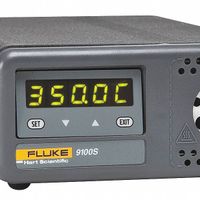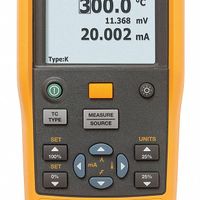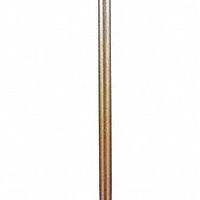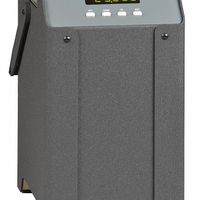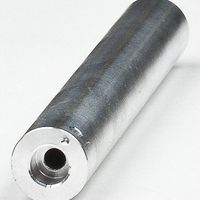Call +(254) 703 030 000 / 751 483 999 / 721 704 777
- Home
- Test Instruments
- Temperature And Environmental Measurement
- Temperature Calibrators
.....Read More
Frequently Asked Questions
What is a temperature calibrator and how does it work?
A temperature calibrator is a device used to verify and adjust the accuracy of temperature measurement instruments, such as thermometers, thermocouples, and RTDs (Resistance Temperature Detectors). It ensures that these instruments provide precise temperature readings, which is crucial in various industries like manufacturing, pharmaceuticals, and food processing.
Temperature calibrators work by providing a stable and known temperature source against which the instrument under test can be compared. There are two main types of temperature calibrators: dry-block calibrators and liquid bath calibrators.
1. **Dry-Block Calibrators**: These devices use a metal block with precisely controlled heating and cooling elements. The block has holes where the temperature sensors are inserted. The calibrator heats or cools the block to a set temperature, and the sensor's reading is compared to the calibrator's known temperature. Adjustments are made to the sensor if discrepancies are found.
2. **Liquid Bath Calibrators**: These use a liquid medium, such as oil or water, to create a uniform temperature environment. The liquid is heated or cooled to the desired temperature, and the sensor is immersed in the liquid. This method provides excellent thermal stability and uniformity, making it suitable for calibrating sensors with irregular shapes.
Both types of calibrators often include a digital display and controls for setting the desired temperature. Advanced models may feature programmable temperature cycles, data logging, and communication interfaces for automated calibration processes.
In summary, a temperature calibrator ensures the accuracy and reliability of temperature measurement devices by providing a controlled temperature environment for comparison and adjustment.
How do you choose the right temperature calibrator for your needs?
To choose the right temperature calibrator, consider the following factors:
1. **Application Requirements**: Determine the specific application, such as industrial, laboratory, or field use, and the type of sensors you need to calibrate (thermocouples, RTDs, thermistors).
2. **Temperature Range**: Identify the temperature range you need to cover. Ensure the calibrator can handle the minimum and maximum temperatures required for your processes.
3. **Accuracy and Stability**: Evaluate the accuracy and stability specifications. Higher accuracy is crucial for precision applications, while stability ensures consistent performance over time.
4. **Portability**: Decide if you need a portable calibrator for fieldwork or a benchtop model for laboratory use. Portability is essential for on-site calibrations.
5. **Functionality**: Consider additional functionalities like data logging, communication interfaces (USB, Bluetooth, Ethernet), and software compatibility for data analysis and reporting.
6. **Ease of Use**: Look for user-friendly interfaces, intuitive controls, and clear displays. This is important for efficient operation and reducing the risk of errors.
7. **Calibration Standards**: Ensure the calibrator complies with relevant industry standards and certifications, such as ISO, NIST, or other national standards, to maintain traceability and reliability.
8. **Environmental Conditions**: Assess the environmental conditions where the calibrator will be used, such as humidity, dust, and temperature fluctuations, and choose a model that can withstand these conditions.
9. **Budget**: Balance your budget with the required features. While higher-end models offer more features and better accuracy, ensure they align with your needs and financial constraints.
10. **Brand Reputation and Support**: Consider manufacturers with a strong reputation for quality and reliability. Check for available customer support, warranty, and service options.
By evaluating these factors, you can select a temperature calibrator that meets your specific needs and ensures accurate and reliable temperature measurements.
What are the differences between dry block and liquid bath temperature calibrators?
Dry block and liquid bath temperature calibrators are both used for temperature calibration, but they differ in several key aspects:
1. **Medium**:
- **Dry Block Calibrators**: Use a solid metal block with drilled holes to insert temperature sensors. The block is heated or cooled to the desired temperature.
- **Liquid Bath Calibrators**: Use a liquid medium, such as oil or water, to immerse the sensors. The liquid is heated or cooled to achieve the target temperature.
2. **Accuracy and Stability**:
- **Dry Block**: Generally offers good stability and uniformity, but may have limitations in accuracy due to air gaps between the sensor and the block.
- **Liquid Bath**: Provides excellent accuracy and stability due to the uniform heat distribution in the liquid, minimizing temperature gradients.
3. **Temperature Range**:
- **Dry Block**: Typically covers a wide temperature range, often from -100°C to 700°C, depending on the model.
- **Liquid Bath**: Also covers a wide range but is often limited by the boiling or freezing points of the liquid used.
4. **Portability**:
- **Dry Block**: More portable and easier to use in the field due to their compact design and lack of liquid handling.
- **Liquid Bath**: Generally bulkier and less portable, requiring careful handling to prevent spills.
5. **Application**:
- **Dry Block**: Ideal for industrial applications where portability and ease of use are important.
- **Liquid Bath**: Preferred in laboratory settings where high precision and accuracy are critical.
6. **Maintenance**:
- **Dry Block**: Requires less maintenance as there is no liquid to replace or manage.
- **Liquid Bath**: Requires regular maintenance to ensure the liquid medium is clean and at the correct level.
7. **Cost**:
- **Dry Block**: Often less expensive due to simpler design and operation.
- **Liquid Bath**: Can be more costly due to the need for high-quality liquids and more complex systems.
How often should temperature calibrators be calibrated or maintained?
Temperature calibrators should be calibrated or maintained at least once a year. However, the frequency can vary based on several factors, including the manufacturer's recommendations, the specific application, the environment in which the calibrator is used, and the criticality of the measurements. In high-precision or critical applications, more frequent calibration may be necessary, potentially every six months or even quarterly.
Environmental conditions such as temperature fluctuations, humidity, dust, and exposure to harsh chemicals can affect the performance of calibrators, necessitating more frequent checks. Additionally, if the calibrator is used extensively or in a demanding environment, it may require more frequent maintenance to ensure accuracy and reliability.
Organizations should also consider their internal quality assurance policies and any industry-specific regulations or standards that might dictate calibration intervals. For instance, industries like pharmaceuticals, aerospace, and food processing often have stringent calibration requirements due to the critical nature of their operations.
Regular calibration ensures that the calibrator provides accurate readings, which is essential for maintaining the integrity of processes and ensuring product quality. It also helps in identifying any potential issues early, reducing the risk of equipment failure and costly downtime.
Ultimately, the calibration schedule should be determined by a risk assessment that considers the factors mentioned above, ensuring that the calibrator remains reliable and accurate for its intended use.
What are the common applications of portable temperature calibrators?
Portable temperature calibrators are essential tools in various industries for ensuring the accuracy and reliability of temperature measurement devices. Common applications include:
1. **Industrial Process Control**: Used in industries like oil and gas, chemical, and pharmaceuticals to calibrate temperature sensors, transmitters, and thermocouples, ensuring precise process control and safety.
2. **HVAC Systems**: Employed by HVAC technicians to verify and calibrate thermostats, temperature sensors, and control systems, ensuring efficient heating, ventilation, and air conditioning operations.
3. **Food and Beverage Industry**: Ensures compliance with safety standards by calibrating temperature monitoring devices in food processing, storage, and transportation, preventing spoilage and ensuring product quality.
4. **Power Generation**: Used in power plants to calibrate temperature sensors and transmitters in turbines, boilers, and other critical equipment, ensuring efficient and safe operation.
5. **Aerospace and Defense**: Critical for calibrating temperature sensors in aircraft and defense systems, ensuring accurate readings for safety and performance.
6. **Automotive Industry**: Used in testing and calibrating temperature sensors in engines, climate control systems, and other automotive components to ensure optimal performance and compliance with standards.
7. **Laboratories and Research**: Essential for calibrating temperature measurement devices in scientific research and testing laboratories, ensuring accurate experimental data.
8. **Medical and Healthcare**: Used to calibrate temperature sensors in medical equipment like incubators, sterilizers, and refrigerators, ensuring patient safety and compliance with health regulations.
9. **Manufacturing**: Ensures the accuracy of temperature sensors in manufacturing processes, affecting product quality and consistency.
10. **Environmental Monitoring**: Used in environmental studies and monitoring stations to calibrate temperature sensors, ensuring accurate data collection for climate and environmental research.
How accurate are handheld temperature probe calibrators compared to other types?
Handheld temperature probe calibrators are generally accurate but their precision can vary based on the model and manufacturer. They are designed for portability and ease of use, making them suitable for fieldwork and on-site calibration. Typically, these devices offer an accuracy range of ±0.1°C to ±0.5°C, which is sufficient for many industrial and laboratory applications. However, this accuracy might not match that of high-end, stationary calibrators, which can achieve accuracies as fine as ±0.01°C.
Compared to other types of calibrators, such as dry-block calibrators or liquid bath calibrators, handheld devices may have limitations in terms of stability and uniformity. Dry-block calibrators, for instance, provide a stable temperature environment and are often more accurate, with better temperature uniformity across the block. Liquid bath calibrators offer excellent stability and uniformity, making them ideal for calibrating highly sensitive or critical temperature sensors.
Handheld calibrators are advantageous for their convenience and versatility, often supporting multiple sensor types and offering quick calibration processes. They are particularly useful for routine checks and less critical applications where extreme precision is not necessary. However, for applications requiring the highest accuracy and stability, such as in metrology labs or for calibrating high-precision sensors, stationary calibrators are preferred.
In summary, while handheld temperature probe calibrators are accurate and convenient for many applications, they may not provide the same level of precision and stability as more sophisticated, stationary calibrators. The choice between them depends on the specific accuracy requirements and the context in which they are used.
What safety precautions should be taken when using temperature calibrators?
When using temperature calibrators, several safety precautions should be observed to ensure safe and effective operation:
1. **Read the Manual**: Familiarize yourself with the manufacturer's instructions and safety guidelines before use.
2. **Personal Protective Equipment (PPE)**: Wear appropriate PPE such as heat-resistant gloves and safety goggles to protect against burns and eye injuries.
3. **Inspect Equipment**: Check the calibrator and its accessories for any signs of damage or wear before use. Do not use if any defects are found.
4. **Proper Ventilation**: Ensure the area is well-ventilated to prevent the accumulation of any hazardous fumes or gases that may be emitted during operation.
5. **Stable Surface**: Place the calibrator on a stable, non-flammable surface to prevent tipping and reduce fire risk.
6. **Temperature Awareness**: Be aware of the high temperatures involved. Avoid direct contact with heated parts and allow the device to cool before handling.
7. **Electrical Safety**: Ensure all electrical connections are secure and that the power supply matches the calibrator's requirements. Use grounded outlets to prevent electrical shocks.
8. **Avoid Flammable Materials**: Keep flammable materials away from the calibrator to prevent fire hazards.
9. **Calibration Environment**: Use the calibrator in an environment free from moisture and dust to prevent damage and ensure accurate readings.
10. **Emergency Procedures**: Be aware of emergency procedures, including the location of fire extinguishers and first aid kits.
11. **Training**: Ensure that all operators are adequately trained in the use of the calibrator and understand the associated risks.
12. **Regular Maintenance**: Perform regular maintenance and calibration checks to ensure the device is functioning correctly and safely.
By adhering to these precautions, users can minimize risks and ensure the safe operation of temperature calibrators.
